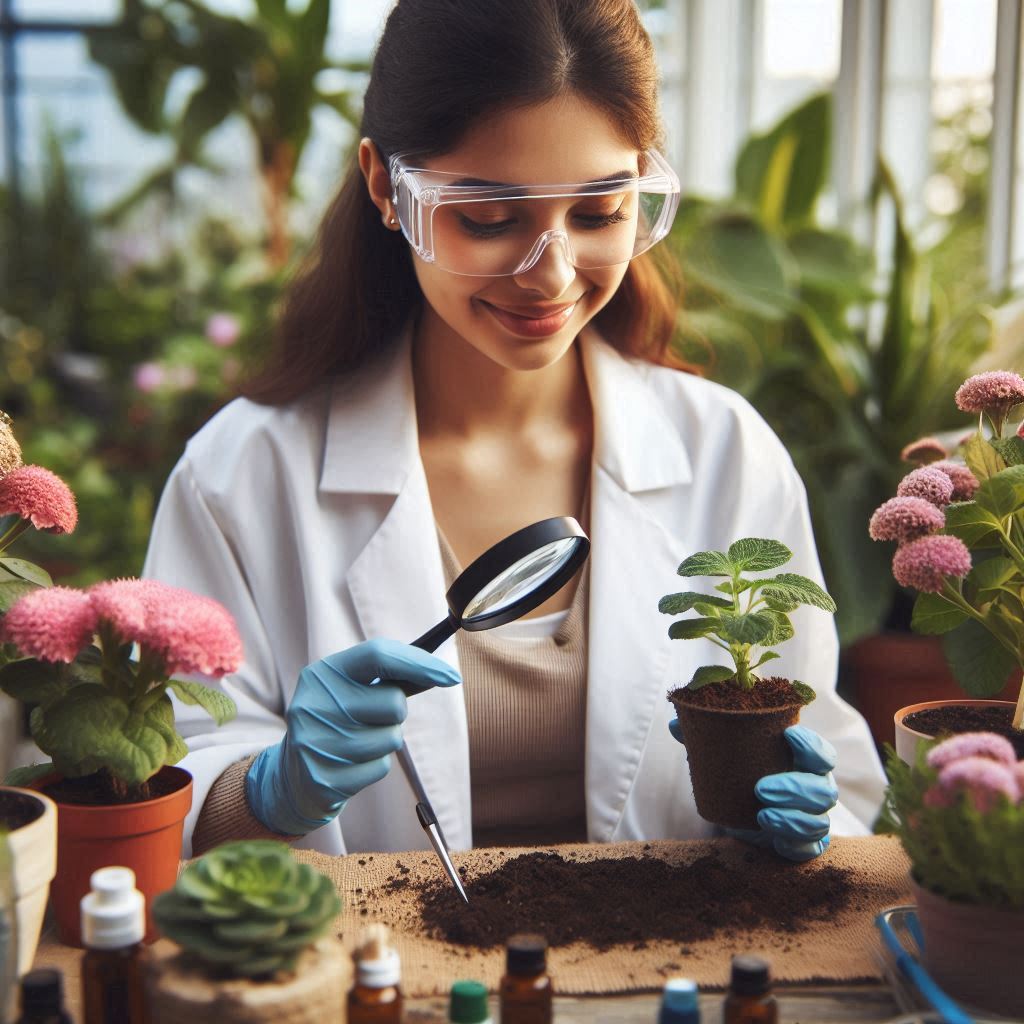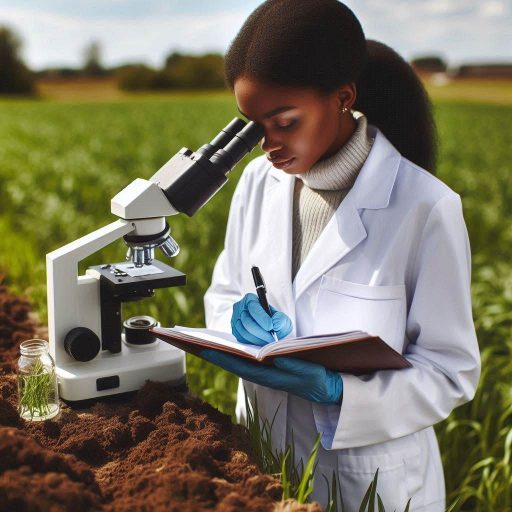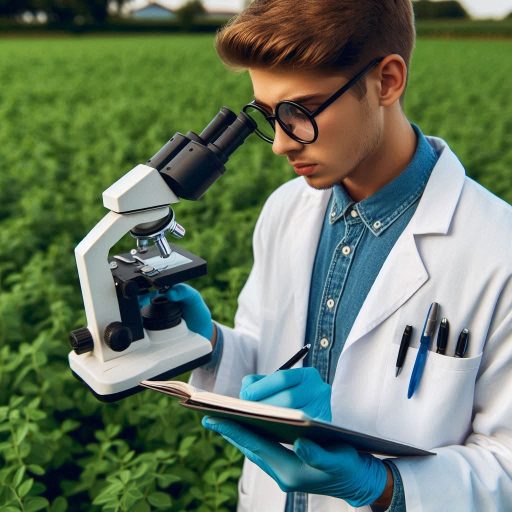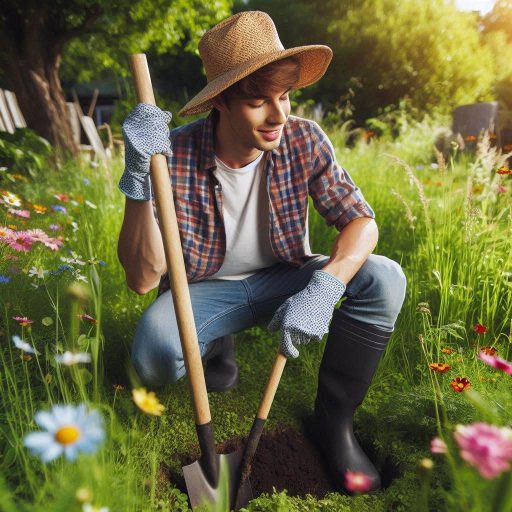Introduction
Soil science projects play a vital role in education for students and beginners.
Understanding soil’s properties and functions is essential for sustainable agriculture and environmental conservation.
Hands-on projects engage learners and make complex concepts more accessible.
These projects encourage critical thinking and problem-solving skills.
By conducting experiments, students gain firsthand experience with soil and its importance.
Engaging with soil science allows learners to see the real-world implications of their studies.
Moreover, hands-on activities foster a deeper appreciation for the environment.
Students learn how soil health directly impacts food production and ecosystem balance.
They explore how soil influences water retention and nutrient cycling.
Such projects also promote teamwork and collaboration among students.
Working together helps develop communication skills and a sense of community.
Additionally, these projects can inspire future careers in agriculture, environmental science, and land management.
Soil science projects are crucial for developing a solid foundation in understanding soil’s role.
They equip students with practical skills and knowledge necessary for addressing global challenges.
Ultimately, these projects empower the next generation to contribute to sustainable practices and protect our planet’s resources.
Importance of Soil Science Education
Why It Is Important for Students and Beginners to Learn About Soil Science
Soil science education is essential for students and beginners because it directly affects agriculture and environmental sustainability.
Soil is the foundation of ecosystems, food production, and plant life, making it critical to understand its properties.
By learning about soil composition, health, and fertility, students gain insights into managing soil for future generations.
Soil science equips students with the knowledge to address global challenges like soil degradation, erosion, and nutrient depletion.
Understanding soil science allows students to recognize the importance of soil conservation.
As human activity threatens soil health, learning how to preserve and restore soil becomes increasingly vital.
Soil science helps students see the direct relationship between soil health and agricultural productivity.
It also fosters a deeper understanding of how soil supports ecosystems and food security.
This knowledge encourages the adoption of sustainable land use practices.
Soil science education also sparks interest in related fields like environmental science, agriculture, and sustainability.
By studying soil, students gain practical skills in testing and analyzing soil, improving their ability to address environmental issues.
It opens the door for hands-on learning experiences, such as fieldwork or lab projects, that reinforce their understanding of the material.
Through these experiences, students develop problem-solving skills to tackle real-world soil challenges.
How Knowledge of Soil Properties and Processes Can Help in Sustainable Agriculture and Soil Conservation
Knowing soil properties helps students understand how soil supports plant growth, water retention, and nutrient availability.
This insight allows students to implement farming techniques that boost productivity while protecting soil health.
Soil science teaches students how practices like crop rotation and composting improve soil fertility and long-term sustainability.
These techniques ensure healthy crop yields and preserve soil structure.
Soil science also plays a significant role in soil conservation, a key factor in mitigating climate change.
Students who understand soil’s ability to sequester carbon can adopt methods like no-till farming and cover cropping.
These sustainable practices enhance organic matter and store carbon in the soil, reducing greenhouse gas emissions.
By learning soil conservation strategies, students contribute to fighting climate change and protecting vital ecosystems.
Understanding soil processes helps students grasp how improper soil management leads to environmental degradation.
Erosion, nutrient depletion, and habitat loss result from poor land management practices.
Soil science gives students the tools to prevent these issues and promote biodiversity.
Techniques that preserve soil health, such as reducing chemical inputs or maintaining soil structure, also protect wildlife habitats and water quality.
Soil science education is essential for students and beginners as it promotes sustainable agriculture and soil conservation.
By learning about soil properties and processes, students can adopt methods that protect soil health, fight climate change, and secure global food systems.
Read: Challenges and Rewards: The Dual Life of an U.S. Environmental Scientist
Easy Soil Science Projects for Beginners
Soil science offers a variety of exciting and educational projects for beginners.
These projects help students understand soil properties and their importance.
Here’s a list of simple and fun projects that students and beginners can start with.
List of Simple and Fun Projects That Students and Beginners Can Start With
Soil Texture Analysis
Soil texture analysis is an excellent starting point for beginners.
This project teaches students about different soil types.
To begin, collect samples from various locations, like gardens or parks.
Next, place each soil sample in a jar and fill it with water.
Shake the jars vigorously and let the soil settle.
Observe the different layers that form.
Students can measure the height of each layer to determine soil texture.
This hands-on activity helps them learn about sand, silt, and clay.
pH Testing
Testing soil pH is another straightforward project.
Soil pH influences plant growth and nutrient availability.
To test pH, gather soil samples and mix them with distilled water.
Use litmus paper or a pH meter to measure the pH level.
Students can compare the pH of different soil samples.
They will learn how acidic or alkaline soils affect plant health.
This project highlights the importance of pH in gardening and agriculture.
Composting Experiments
Creating a compost pile is an enjoyable and educational project.
Composting teaches students about organic matter and soil enrichment.
To start, gather kitchen scraps like vegetable peels, eggshells, and coffee grounds.
Collect yard waste like leaves and grass clippings.
Layer the materials in a compost bin or pile.
Turn the pile regularly to aerate it and speed up decomposition.
Over time, students will observe how organic matter breaks down into rich compost.
This compost can enhance soil fertility and structure.
Include Projects Like Soil Texture Analysis, pH Testing, and Composting Experiments
Soil Moisture Monitoring
Soil moisture monitoring is a practical project that helps students understand water retention.
Begin by collecting soil samples from different areas.
Place the samples in containers and water them equally.
Use a moisture meter or simple observation to check moisture levels over time.
Students will learn how different soil types retain moisture.
This project reinforces the importance of soil moisture for plant growth.
Earthworm Habitat Study
Studying earthworms provides insights into soil health and aeration.
Create a simple habitat for earthworms using a transparent container.
Fill the container with soil and add some organic matter.
Introduce a few earthworms into the habitat.
Observe how they move through the soil and how they impact soil structure.
Students can learn about the role of earthworms in nutrient cycling and soil health.
Plant Growth Experiment
Conducting a plant growth experiment allows students to apply their knowledge practically.
Use different soil types to plant seeds.
Monitor and record the growth of the plants over several weeks.
Students can analyze how soil composition affects plant growth.
This experiment highlights the connection between soil health and successful gardening.
These easy soil science projects engage beginners and foster a deeper understanding of soil.
Each project offers hands-on learning experiences that illustrate soil’s vital role in the environment.
By exploring these projects, students can cultivate a lifelong interest in soil science.
Read: Job Market Trends: Future of Chemistry Jobs in America
Advanced Soil Science Projects for Intermediate Students
Intermediate students with a foundational understanding of soil science can tackle more complex projects.
These advanced projects deepen their knowledge and critical thinking skills.
Here are some challenging project ideas for these students.
More Challenging Projects for Students Who Have Some Basic Understanding of Soil Science
Studying Soil Erosion
Studying soil erosion offers valuable insights into land degradation.
Students can begin by selecting a local area prone to erosion.
They should observe the landscape and collect soil samples from various locations.
Next, they can design experiments to measure erosion rates.
They might simulate rainfall on different soil types to observe erosion patterns.
Students can compare the effects of vegetation on erosion control.
This project teaches them about soil conservation and its importance for sustainable land use.
Nutrient Cycling
Investigating nutrient cycling in ecosystems helps students understand soil fertility.
Students can set up small plots with various plants.
They should monitor how nutrients move through the soil-plant system.
By measuring plant growth and soil nutrient levels, students can analyze the relationship between them.
They can also explore how different fertilizers affect nutrient cycling.
This project emphasizes the role of soil in supporting healthy ecosystems and agriculture.
Soil Remediation Techniques
Exploring soil remediation techniques allows students to address real-world environmental issues.
They can investigate contaminated soils and study different remediation methods.
For example, students might focus on phytoremediation, which uses plants to clean contaminated soil.
They can select specific plants known for their ability to absorb pollutants.
By measuring the effectiveness of these plants, students will learn about sustainable remediation strategies.
This project highlights the importance of healthy soils for community health.
Examples Could Include Studying Soil Erosion, Nutrient Cycling, and Soil Remediation Techniques
Analyzing Soil Microbial Activity
Understanding soil microbial activity is crucial for soil health.
Students can set up experiments to measure microbial activity in different soil samples.
They can use respiration tests to gauge microbial respiration rates.
By comparing samples from healthy and degraded soils, students can draw conclusions about soil health.
This project emphasizes the role of microorganisms in nutrient cycling and soil fertility.
Assessing Soil Compaction
Assessing soil compaction helps students learn about soil structure and porosity.
Students can investigate how compaction affects water infiltration and root growth.
They can design experiments to test different compaction levels.
By measuring infiltration rates and plant growth, they can analyze the impact of compaction.
This project highlights the importance of maintaining healthy soil structure for agriculture.
Soil Quality Index Development
Developing a soil quality index allows students to integrate their knowledge of soil properties.
They can select key indicators, such as pH, organic matter, and texture.
Students should collect data from various soil samples and calculate an overall soil quality index.
This project teaches them how to evaluate soil health comprehensively.
It emphasizes the need for consistent soil monitoring in sustainable agriculture.
These advanced soil science projects engage intermediate students and deepen their understanding of soil systems.
Each project encourages critical thinking and problem-solving skills.
By tackling these challenges, students develop a greater appreciation for soil science.
These projects prepare them for future studies or careers in environmental science and sustainable agriculture.
Transform Your Career Today
Unlock a personalized career strategy that drives real results. Get tailored advice and a roadmap designed just for you.
Start NowRead: Challenges and Rewards: Navigating the Chemist Career Path

Resources and Materials Needed
Conducting soil science projects requires various tools and materials.
Students and beginners should gather the necessary supplies to ensure successful experiments.
This guide outlines essential equipment and suggests where to obtain them.
Necessary Tools, Equipment, and Materials for Conducting Soil Science Projects
Basic Soil Sampling Tools
To collect soil samples, students need basic tools.
A soil auger or spade works well for sampling.
They can also use a trowel for smaller projects.
Make sure to have clean containers for collecting samples.
Label each container clearly for easy identification.
Soil Testing Kits
Soil testing kits are essential for analyzing soil properties.
These kits typically include pH testers, nutrient analysis tools, and moisture meters.
Look for comprehensive kits that cover multiple tests.
Many local garden centers and agricultural supply stores sell these kits.
Online retailers also offer a wide selection.
pH Testing Materials
For pH testing, students can use pH test strips or digital pH meters.
Test strips are cost-effective and easy to use.
Digital meters provide more precise readings.
Purchase these items at garden supply stores or science education retailers.
Composting Supplies
Composting projects require specific materials.
Students need a compost bin or heap to collect organic waste.
They can use kitchen scraps, yard waste, and shredded paper.
A thermometer can help monitor the compost’s temperature.
This ensures effective decomposition.
Recommendations for Where to Purchase Supplies or Where to Find Them for Free
Free Soil Sampling Opportunities
Students can often find free soil sampling opportunities through local agricultural extension offices.
Many universities offer soil testing services at little to no cost.
Local farmers may also provide access to their land for sampling.
Local Gardening Clubs and Community Gardens
Joining local gardening clubs or community gardens can provide access to tools and materials.
Members often share equipment and resources.
These organizations may offer workshops and training sessions focused on soil science.
Online Resources and Forums
Numerous online resources and forums cater to soil science enthusiasts.
Websites like the USDA’s Natural Resources Conservation Service offer valuable information and tools.
Additionally, educational platforms may provide free downloadable resources for soil science projects.
Science Supply Companies
Many science supply companies offer a wide range of tools and materials for soil science projects.
Companies like Carolina Biological Supply and Flinn Scientific provide quality educational materials.
Check their websites for catalogs and special offers.
Local Hardware and Garden Centers
Local hardware stores and garden centers are excellent places to find soil science materials.
They typically stock soil testing kits, gardening tools, and composting supplies.
Visiting these stores supports local businesses while obtaining necessary supplies.
Gathering the right resources and materials is crucial for successful soil science projects.
Students should ensure they have the necessary tools for collecting and analyzing soil samples.
By utilizing local resources, online platforms, and community organizations, students can access quality materials at affordable prices.
Engaging in these projects will enhance their understanding of soil science and its importance.
Read: Diverse Career Paths: From Chemist to Patent Attorney in the US
Step-by-Step Instructions
Providing clear step-by-step instructions for soil science projects ensures students can easily follow each process.
This section offers detailed guidance for various projects, emphasizing safety precautions and tips for accurate data collection and analysis.
Instructions for each project, breaking down the process into manageable steps
For soil texture analysis, gather materials such as soil samples, water, a clear container, and a ruler.
First, prepare the samples by air-drying them.
Then, mix soil with water in the container, stirring thoroughly.
Allow the mixture to settle for several hours, observing layers forming.
Measure the height of each layer with the ruler and record the results.
Finally, calculate the percentages of sand, silt, and clay based on these measurements.
For pH testing, collect a soil sample, distilled water, a pH meter, and a mixing container.
Mix one part soil with two parts distilled water in the container.
Stir thoroughly to create a slurry.
Insert the pH meter into the mixture and wait for the readings.
Record the pH level, which indicates the soil’s acidity or alkalinity.
For composting experiments, gather kitchen scraps, yard waste, and a compost bin.
Start by layering brown materials like leaves and green materials like vegetable scraps.
Maintain moisture by ensuring the compost pile is moist but not soggy.
Rotate the compost every few weeks to aerate it and speed up decomposition.
Use a thermometer to check internal compost temperatures regularly.
Safety precautions and tips for accurate data collection and analysis
Safety is essential when conducting soil science projects.
Always wear gloves when handling soil samples to avoid skin irritation.
Use safety goggles when testing soil pH, as some solutions may be irritating.
Ensure proper ventilation when mixing compost materials to avoid inhaling dust.
Accurate data collection is vital for reliable results.
Use calibrated equipment, such as pH meters, for precise measurements.
Take multiple readings and calculate averages to ensure accuracy.
Record all observations in a lab notebook immediately to avoid forgetting details.
When analyzing results, consider using graphs to visualize data trends.
Label each axis clearly and choose appropriate scales for easy interpretation.
Discuss findings with peers to gain insights and different perspectives.
Encouraging students to reflect on their processes helps solidify their understanding of scientific methods.
They should ask questions about what worked well and what could be improved.
Documenting these reflections fosters critical thinking and enhances their learning experience.
Providing detailed step-by-step instructions for soil science projects helps students understand processes clearly.
Prioritizing safety precautions and accurate data collection enhances project reliability.
Engaging students in thoughtful analysis and reflection cultivates a deeper appreciation for soil science.
Presentation and Analysis of Results
Organizing and presenting findings from soil science projects enhances understanding and encourages critical thinking.
This section guides students and beginners on how to effectively present their results.
It also discusses the importance of data interpretation and drawing conclusions based on findings.
How students and beginners can organize and present their findings from the soil science projects
Students should start by compiling all data collected during their experiments.
This includes measurements, observations, and notes from each project.
Organizing data into tables can provide clarity, and each column and row should be clearly labeled to avoid confusion.
Graphs are also effective tools for visualizing data trends; bar graphs work well for comparing categories, while line graphs can display changes over time.
Next, students should summarize their key findings for each project, highlighting significant results and any surprising outcomes.
Incorporating visual aids, such as photos, diagrams, and charts, enhances understanding and keeps the audience engaged.
When it comes to presenting results, students should choose a format that suits their audience.
Options include posters, PowerPoint slides, or oral presentations.
Structuring the presentation into clear sections is crucial.
Starting with an introduction, followed by methods, results, and conclusions, creates a logical flow.
Practicing the delivery several times boosts confidence and clarity.
Engaging the audience during the presentation encourages questions and discussions, fostering a collaborative learning environment.
Concluding effectively by summarizing the main points emphasizes the significance of the findings and their implications.
Importance of data interpretation and drawing conclusions based on the results
Analyzing results is essential for understanding the data collected.
Students should carefully examine their findings to look for patterns, trends, and anomalies that may reveal insights.
Formulating conclusions based on data analysis is crucial, as it allows students to state clearly what their results indicate about soil properties and processes.
Acknowledging any limitations in experiments adds depth to the analysis.
Discussing potential sources of error that may affect findings shows critical thinking.
Relating results to theoretical concepts learned in soil science strengthens understanding and illustrates practical applications.
Additionally, suggesting areas for further investigation based on findings encourages ongoing exploration in soil science.
Communicating findings effectively enhances learning and communication skills.
Sharing results with classmates, participating in science fairs, or writing articles can increase awareness of soil science and inspire others to engage in similar projects.
Organizing and presenting findings effectively fosters critical thinking and enhances communication skills.
Understanding data interpretation is vital for making meaningful conclusions and promoting a deeper appreciation for the complexities of soil science.
Engaging in these practices encourages students and beginners to explore the exciting world of soil science.
Showcase Your Business Today
Reach thousands of readers actively exploring professional services. Publish your business profile and grow your audience now.
Publish NowReal-Life Applications of Soil Science
Soil science plays a critical role in various real-life scenarios.
Understanding soil properties and processes helps address pressing environmental and agricultural challenges.
This section explores how knowledge from soil science projects applies to agriculture, environmental conservation, and urban planning.
How the knowledge gained from these projects can be applied in real-life scenarios
Students who engage in soil science projects gain valuable insights.
They learn about soil composition, texture, and pH, which are crucial for effective land management.
This knowledge can be applied directly to enhance agricultural practices.
For instance, farmers can optimize soil health to increase crop yields.
Additionally, understanding soil properties enables better management of natural resources.
Students can identify soil erosion issues and develop strategies to mitigate them.
They can also assess soil contamination levels and recommend remediation techniques.
This knowledge helps protect the environment and promotes sustainability.
Examples of how soil science concepts are used in agriculture, environmental conservation, and urban planning
In agriculture, soil scientists assess soil health to guide sustainable farming practices.
They recommend cover cropping and crop rotation to maintain soil fertility.
Farmers who implement these practices reduce reliance on chemical fertilizers, leading to healthier ecosystems.
Environmental conservation relies heavily on soil science.
Soil scientists study erosion patterns and soil degradation to develop restoration strategies.
They also monitor soil health in natural habitats to protect biodiversity.
For example, reforestation projects often involve soil analysis to ensure the chosen species thrive in specific soil types.
Urban planning increasingly incorporates soil science concepts.
City planners evaluate soil properties to inform land use decisions.
Understanding soil stability and drainage helps prevent construction issues.
For instance, engineers may recommend soil remediation before building on contaminated sites.
Moreover, soil science informs green infrastructure initiatives.
These projects aim to enhance urban resilience against climate change.
Incorporating permeable surfaces and green spaces improves soil health and reduces stormwater runoff.
Cities can adapt to changing climates by using soil science to design sustainable landscapes.
Students can also apply soil science knowledge to community gardens and urban agriculture.
They can analyze soil samples to determine nutrient levels and pH.
This information helps gardeners choose suitable crops for their soil type.
By understanding soil health, community members can produce fresh food and promote local food systems.
The knowledge gained from soil science projects has practical applications across various fields.
Students learn valuable skills that can enhance agricultural practices, support environmental conservation, and inform urban planning.
By applying soil science concepts, they contribute to sustainable solutions for real-world challenges.
These experiences foster a deeper appreciation for the vital role of soil in our ecosystems.
Conclusion
This blog post emphasized the importance of soil science projects for students and beginners.
Understanding soil properties is crucial for sustainable agriculture and environmental conservation.
Engaging in hands-on projects fosters critical thinking and enhances learning.
Simple and advanced projects allow students to explore real-life applications of soil science concepts.
These experiences deepen appreciation for soil’s role in ecosystems and daily life.
Knowledge gained from these projects can influence decisions in agriculture, urban planning, and environmental management.
We encourage readers to try these projects to enhance their understanding of soil science.
Participating in these activities helps individuals contribute to a sustainable future.
Soil science education empowers individuals to make informed decisions about land use and resource management.
By exploring soil science, you can develop valuable skills and insights.
These projects also promote teamwork and collaboration among peers.
Embrace the opportunity to learn more about the fascinating world of soil.
Soil science is vital for our planet’s health and sustainability.
Delve into these projects and discover the many ways soil impacts our lives.
Your journey in soil science can lead to a better understanding of our environment and its preservation.
[E-Books for Sale]
The Big Book of 500 High-Paying Jobs in America: Unlock Your Earning Potential
$19.99 • 500 High-Paying Jobs • 330 pages
Explore 500 high-paying jobs in America and learn how to boost your career, earn more, and achieve success!
See All 500 High-Paying Jobs of this E-Book
1001 Professions Without a Degree: High-Paying American Jobs You Can Start Now
$19.99 • 1001 Professions Without a Degree • 174 pages
Discover 1001 high-paying jobs without a degree! Unlock career tips, skills, and success strategies for just $19.99!




